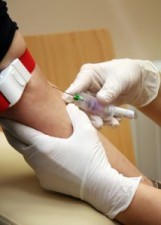 At last, the FDA has decided to drop one of its shoes by allowing men who have sex with men to donate blood that is if they've abstained from this practice for the entire year before the donation.
At last, the FDA has decided to drop one of its shoes by allowing men who have sex with men to donate blood that is if they've abstained from this practice for the entire year before the donation.
This change in official government policy is based on solid scientific evidence, and is surely a major advance, as compared to 1983's total ban on such donations. But is it still too stringent, particularly as we face frequent blood shortages?
One the one hand, the FDA's studies and procedures have led to a risk of HIV contraction from a blood donation of about one in 1.4 million. That's less than the odds of winning most lotteries, and the agency deserves to be commended for that. And their review of other country's policies United Kingdom, Sweden, Japan and Australia confirmed the very, very low risk using these criteria. Indeed, its review of Australia's identical policy found a similar barely-detectable risk of transmission from their eight million transfused units since 2000.
On the other hand, when the FDA announced that it was considering this change last May, we said this:
"There is a window in which a person can be harboring the virus, but a test for them will generate a false negative. For HIV it can be up to 6 months (hep C is up to 9). Furthermore, the incidence in the MSM [men having sex with men] community of HIV is still high, as they account for 63 percent of all new HIV infections in America. Therefore, the FDA s new policy appears to have some sound science, although the full year appears to be taking it to an extra layer of precaution."
And the American Council's Dr. Josh Bloom was even more disdainful at the time about the new policy:
"I ve said this before: there are newer assays that are so sensitive that they can detect minuscule amounts of the RNA from the virus. The problem is that groups like the Red Cross are using older antibody tests, which can take six months to reveal the presence of the virus. PCR tests detect genetic material from the virus itself, are extremely accurate and much faster. These tests require only a 10-12 days to determine if the virus is present. Furthermore, when the quantity of virus is so low that it can t be measured (this is called below detectable limits ) the chances of transmission are far lower."
Note that the lifetime ban on anyone who's ever been HIV positive; has traded sex for money or drugs; or has ever used injection drugs illicitly; remains intact. The FDA added that this measure was also aimed at detecting hep-B and C, and STDs.
So what's the bottom line?
At first glance, it seems like a valid policy, but as a David Stacy of The Human Right Campaign said, again from our May 2015 article: "This policy prevents men from donating life-saving blood based solely on their sexual orientation rather than actual risk to the blood supply. It simply cannot be justified in light of current scientific research and updated blood screening technology."
While that may be true enough, given the fact that the Red Cross apparently still uses older detection equipment, it may be best to await their updating of their technology before allowing full donation privileges.


